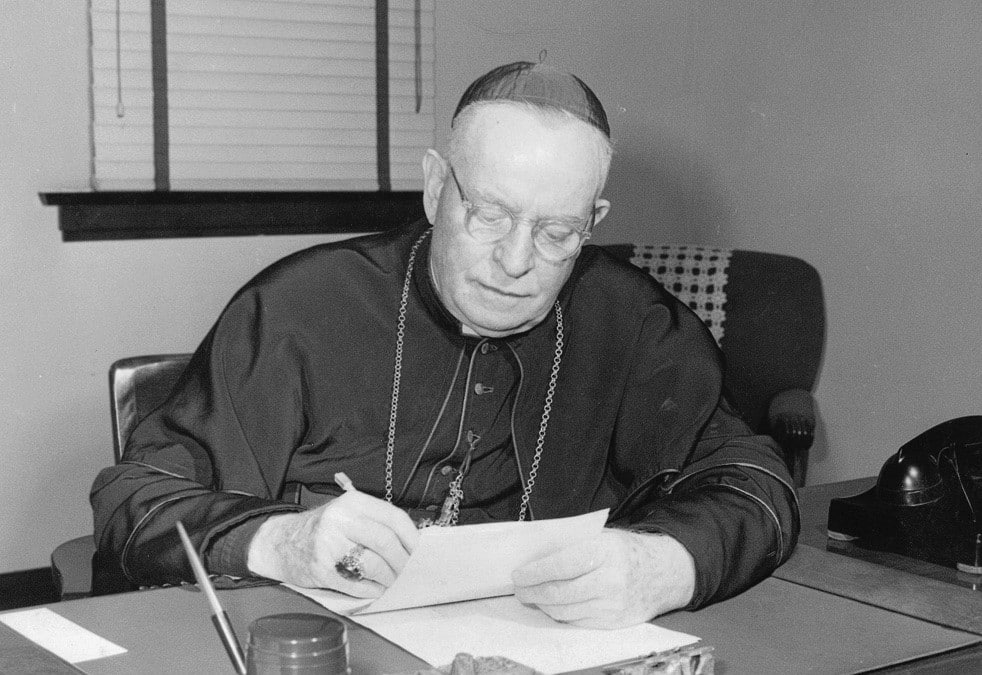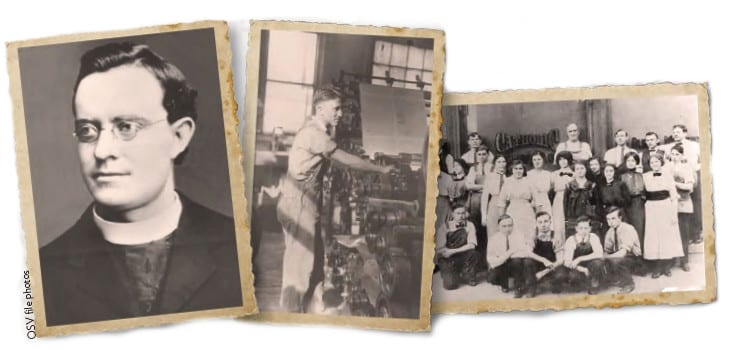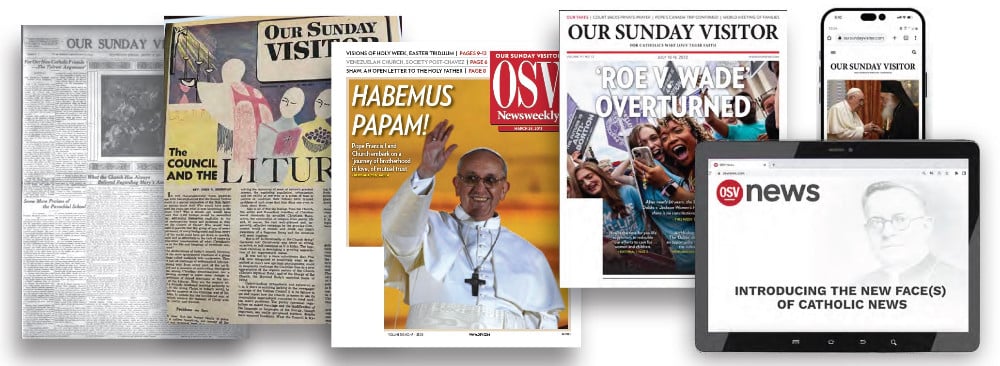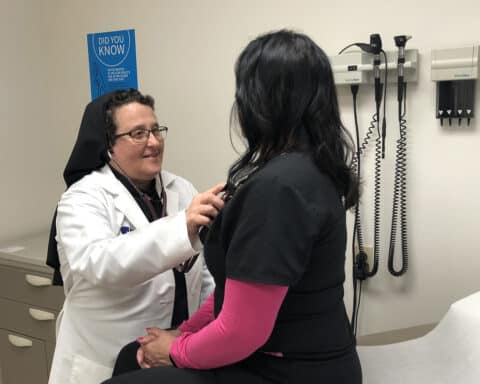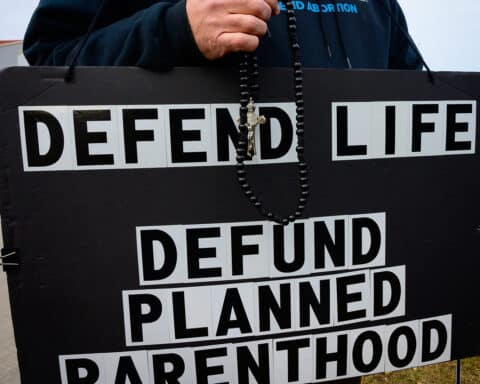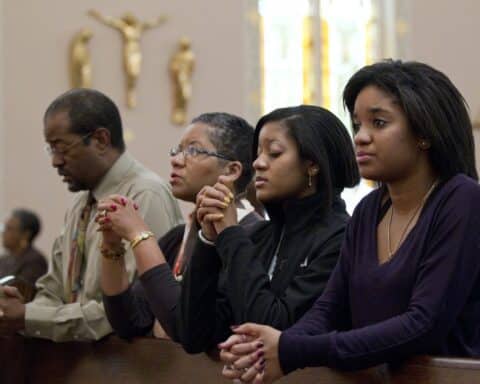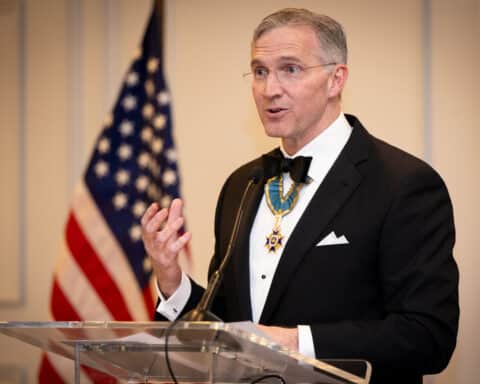In the second issue of Our Sunday Visitor (May 12, 1912), then-Father John Francis Noll declared, “We doubt if a paper was ever issued which was more warmly welcomed by the Catholic clergy than the first number of Our Sunday Visitor was.” From the beginning, Father Noll’s project met a real need and was highly regarded.
One hundred and 10 years later, Father Noll’s newspaper remains OSV’s flagship publication. But faithful to his spirit of innovation, OSV continues to grow and change. To mark Our Sunday Visitor’s 110th anniversary year, May 12, 2022-May 12, 2023, it is our great pleasure to share the story of our founder, a word about our current projects, and to look with hope to a bright future.
Where it all started
By Msgr. Owen F. Campion
In Our Sunday Visitor’s photo archives is a photograph showing then-Bishop John Francis Noll in conversation with former New York Gov. Alfred Emmanuel Smith in 1929. They were at Notre Dame University, where Smith had just received the prized Laetare Medal, annually given to the person who, in the university’s judgment, is America’s most distinguished Catholic.
Bishop Noll, later archbishop, and Smith represent what Catholics in this country experienced, and what saturated American society, between the two world wars, and how Archbishop Noll worked to fortify and empower Catholics.
Anti-Catholic America
John Francis Noll was born on Jan. 25, 1875, in Fort Wayne, Indiana. He attended parochial schools and went to the seminary. On June 4, 1898, he was ordained a priest of the Diocese of Fort Wayne.
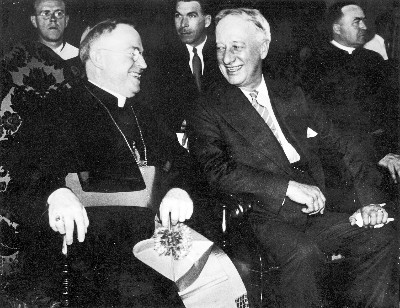
Alfred Smith came from a totally different upbringing. His maternal grandparents were from Italy, his grandparents on his father’s side emigrated from Italy. His family was Catholic. To help the family financially, Smith left St. James Parochial School in Lower Manhattan before completing the eighth grade and found a job in a wholesale fish market on New York’s docks.
Al Smith was smart. He took the bull by the horns. Neighbors elected him to the New York legislature. He made a name for himself, in the best sense. He was elected three times to the governorship of New York.
In 1928, the Democrats nominated Smith for president. Then erupted a volcano of anti-Catholicism that, political analysts agreed, defeated him, leaving Catholic Americans staggering, accused of disloyalty to the country, and in so many ways regarded as different from “good” Americans.
Father, then Bishop, Noll knew this anti-Catholic bigotry very well.
Bishop Noll’s successor, now deceased Bishop Leo A. Pursley, said that when he himself was ordained a priest in 1927, Catholic priests and nuns wore their religious garb on the streets of many Indiana small towns at their own risk. If lucky, they were only insulted or cursed.
It was the heyday of the violently anti-Catholic Ku Klux Klan.
Congress enacted the immigration quota law, thinly disguised legislation drawn to keep Catholics out of this country. Lithuanians, Poles and Slovaks, usually Catholics, found it hard, or impossible, to enter this country. The rule for Scots or Swedes, most often Protestants, was come one, come all.
Attempts even were made to close Catholic schools by force of law. The U.S. Supreme Court, in its 1925 ruling, Pierce v. Society of Sisters of the Holy Names of Jesus and Mary, stopped that.
In state legislatures and in Congress, politicians urged outlawing wearing Catholic apparel, Roman collars and habits, in public. Four states passed laws allowing police, despite the Fourth Amendment to the U.S. Constitution, to invade Catholic convents to discover “vice” or to “rescue” nuns held against their will.
Businesses openly refused to hire Catholics. Rare was the Catholic judge. Catholics most often were anything but well to do, having no pull anywhere.
Many Catholics, understandably, were nervous, silent or doubtful. American Catholics never went underground, but they frequently lived virtually in enclaves, in their own urban neighborhoods or on their isolated farms. To their credit, they, and their forebears, cared for the needy among them, building their own hospitals, facilities for the poor, the orphaned and the helpless, even their own colleges and universities, such as Notre Dame, Creighton and Providence College.
Not uncommonly, they heard less than friendly questions. Why did they go to confession? Why did they revere the mother of Jesus? Many, like Smith, had limited religious education.
Starting Our Sunday Visitor
Amid all this, Father Noll was named pastor of St. Mary’s Parish, in Huntington, Indiana.
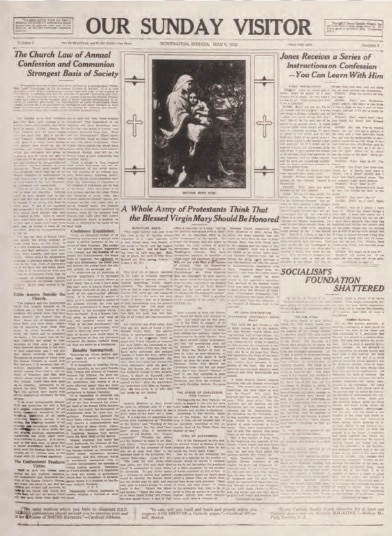
By chance, a printing press, located about two blocks from Father Noll’s parish, went on the market. Father Noll saw an opportunity. With a newspaper, he could enable and encourage Catholics facing ill will. He could promote the Faith.
He acquired the press and, using his own money, started a national newspaper chiefly to combat, and to discredit, anti-Catholicism. The newspaper went to Catholics in Boston, Cleveland, Philadelphia, Chicago and San Francisco, but also in Crestline, Ohio, Waycross, Georgia, Big Spring, Texas, and McCook, Nebraska.
Always, preparing Catholics for the silly charges voiced, often boisterously, by bigots, was a high objective. (In 1928, it was said, and many people fell for it, that Smith’s first action as president would be to prepare quarters in the White House for Pope Pius XI, who would leave Rome, move to Washington, and, using Smith as a senseless, compliant pawn, rule the United States.)
In time, other publications followed, such as The Priest, designed to assist priestly ministry, and then books about Catholic doctrine, piety and Church history.
The objective was to give Catholics confidence in discussing religion but also in seeing themselves as patriotic Americans. Our Sunday Visitor published catechetical helps, books on Catholic doctrine, piety and the saints.
A wider legacy
Father Noll wanted Catholics to be proud of their Church and to see themselves as American as anyone, and their beliefs are as noble and valid as anyone’s. To press this point, he urged Catholics, in his columns in Our Sunday Visitor, to aid in building the National Shrine of the Immaculate Conception, a most imposing Church, in Washington, D.C. They did as they were asked. (In the shrine today is a bust of Archbishop Noll, acknowledging his vital support.)
Archbishop Noll noticed that while memorials celebrating politicians and generals crowded the nation’s capital, no image of Christ appeared anywhere. With Our Sunday Visitor as his contact to American Catholics, Bishop Noll called for a monument to Jesus to be placed in some prominent place in Washington. Readers of the newspaper rallied to the cause. The result was the magnificent, quite large, statue of Christ, the Light of the World. It stands today in front of the headquarters of the U.S. Conference of Catholic Bishops.
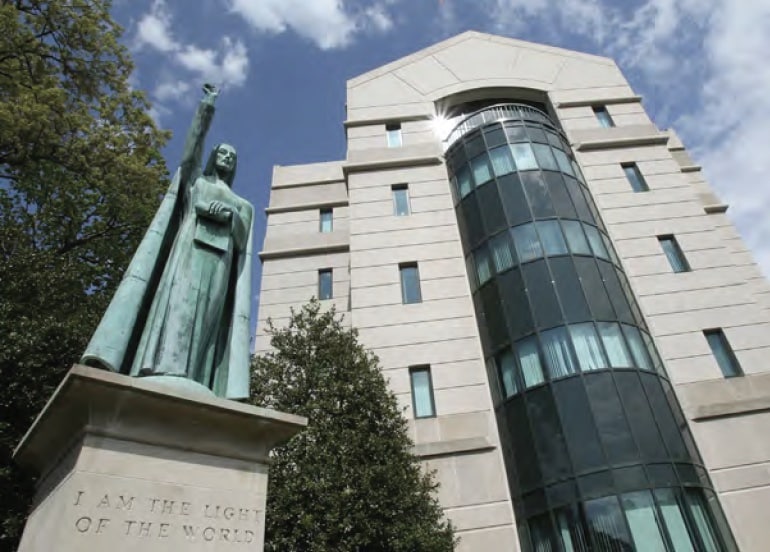
In Huntington, at St. Mary’s, unusual for his time, Father Noll mixed and mingled with the wider population, joining the Rotary Club and cooperating with Protestants and Protestant clergy for the common good. He learned that many Protestant congregations used envelopes to receive and tabulate donations.
Our Sunday Visitor began producing offertory envelopes for Catholic parishes. Soon, virtually every Catholic church in America received monetary gifts, and kept track of them, with envelopes provided by Our Sunday Visitor.
To assist Catholic causes across the country, Our Sunday Visitor formed the Our Sunday Visitor Institute as a philanthropy.
Recognizing exceptional service to the Church, Pope Pius XII, in 1953, gave Bishop Noll the personal title of “archbishop,” a designation rarely conferred upon bishops who do not head archdioceses.
When Archbishop John Francis Noll died on July 31, 1956, “Our Sunday Visitor” was a household word among American Catholics, the largest Catholic print publication in the English-speaking world. However, Archbishop Noll should not be remembered primarily as a publisher, editor or writer, but as a disciple of the Lord Jesus. He was a disciple, with the mind of a pastor, who was eager, creative and driven by the love of Christ.
Msgr. Owen F. Campion is OSV’s chaplain.
What Catholic media needs
By Scott P. Richert
“I pray not only for them, but also for those who will believe in me through their word, so that they may all be one, as you, Father, are in me and I in you, that they also may be in us, that the world may believe that you sent me” (Jn 17:20-21).
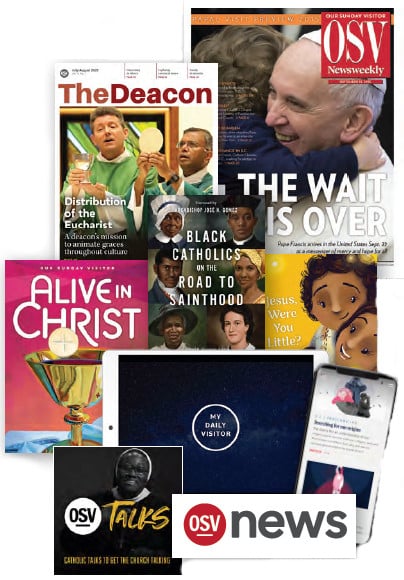
From our first days, OSV (the entire company’s efforts to publish Catholic products, such as Our Sunday Visitor, and to serve parishes) has been on a mission — the mission of Catholic publishing — to bring that truth to everyone: to animate the life of Christ in the hearts of faithful Catholics; to revive it in those who have fallen away; and to introduce the source of life to those who do not yet know Christ, or who have not yet experienced the fullness of his truth, which is found in the Catholic Church.
In creating everything through which we proclaim the truth of Christ — our periodicals (Our Sunday Visitor, The Priest, The Deacon, OSV Kids, L’Osservatore Romano); our books; our curriculum and catechetical products (Alive in Christ, Faith Fusion, Allelu, Encounter With Christ, Real + True); our pamphlets and other parish products, such as the “My Daily Visitor” line of devotionals; OSV Podcasts; OSV Talks; and now OSV News, our new Catholic newswire — we live by one guiding principle: Speaking the truth in charity, in a way that unites.
Charity and unity never modify or dilute the truth; rather, charity is the means by which truth comes into the world and plants its seed in the hearts and minds of men and women, and unity is the fruit that is borne when that seed sprouts and blossoms. All truth is God’s truth, and to the extent that we come to experience that reality in our souls, all Christians long to be one, as the Son and the Father are one.
Because the sources of division are strong, numerous and exceedingly vocal, it is all too easy even for those who desire unity to be caught up in political battles and cultural wars that divide us and draw us away from truth, away from Christ, away from his Church. That is precisely why Catholic publishing is so essential today, in all media: video, audio, digital, social, and — yes — print. When the Church withdraws from any particular medium, or we proclaim the truth only to those who already know it, we fail in our mission to bring the truth — to bring Christ — to all.
From the very first issue of Our Sunday Visitor, OSV has engaged our culture when it has gone astray. A healthy culture provides the soil in which the seed of truth can flourish, but the only way to keep a culture healthy is by constantly scattering those seeds on all ground, no matter how rocky. To do so doesn’t make the Church or Catholic publishing political, or a “combatant” in the “culture wars”; it means that we are living the Great Commission, to make disciples of all.
The work of Catholic publishing isn’t confined just to those who make their living putting out periodicals and books and videos and podcasts. Everyone who reads these words is an active participant in our work. Our efforts to form and inform our readers, to help them foster their devotional life that they may draw closer to Christ, would not be possible without your prayers and support. The unity fostered by truth is a unity of purpose, an evangelical impulse set on fire by charity, to bring that truth to everyone, so that, as Christ prayed to our Heavenly Father, we may all be one.
That is the mission of Catholic publishing that thousands of OSV employees, and millions of OSV readers, have lived over the past 110 years. That is the mission that still animates our work, and yours, today.
Scott P. Richert is publisher for OSV.
The future of Catholic news
By Gretchen R. Crowe
Since the beginning, the Church has depended greatly on effective communicators. Mary Magdalene ran from the empty tomb declaring clearly and definitively to Jesus’ apostles: “I have seen the Lord.” The 11 themselves were sent into the world to share the Gospel and to baptize all nations. St. Paul traveled far and wide and wrote eloquent letters to early communities of faith, teaching and encouraging them as they grew.
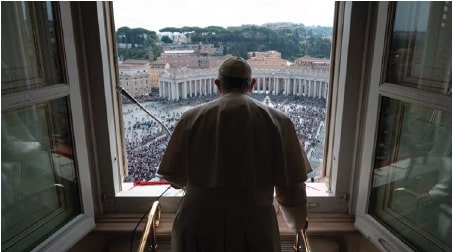
No matter the era of communications — be it one reliant on word of mouth, the printing press or the internet — the Church has, out of basic necessity, been “all in” when it comes to sharing information. What good is the Good News if there is no one or no way to spread it?
When it comes to communication, especially in the 21st century, the means are many and varied, and they ebb and flow with societal and technological advances. But permit me to say there is one mode of communication within the Church that cannot be allowed to fall into oblivion, and that is the Catholic press.
Only through a robust, informed, dedicated and faithful Catholic press can the Church truly accomplish its mission of evangelization. But don’t just take my word for it. Since the late 1800s, and amplified in a particular way since the Second Vatican Council, social communications has been a topic of interest, discussion, thought and prayer within the Church. In particular, the Council Fathers, in their decree on communications, said that a “truly Catholic press” must be established “with the clear purpose of forming, supporting and advancing public opinion in accord with natural law and Catholic teaching and precepts.” Its task, they continued, should be to “disseminate and properly explain news concerning the life of the Church” (Inter Mirifica, No. 14).
In Communio et Progressio, a longer, more specific implementation document issued a few years after the council, the former Pontifical Council for Social Communications said the Catholic press “can be marvelously effective in bringing a knowledge of the Church to the world and a knowledge of the world to the Church” (No. 137). A few years after that, Pope St. Paul VI, in his apostolic exhortation on evangelization, Evangelii Nuntiandi, said when social communications are “put at the service of the Gospel, they are capable of increasing almost indefinitely the area in which the Word of God is heard” (No. 45).
The last three popes each have been vocal on the importance of communications in their own ways. The final document issued by Pope John Paul II, on the rapid development of technology, echoed the council, saying, “communication must tend toward a constructive dialogue, so as to promote a correctly-informed and discerning public opinion within the Christian community.” Pope Benedict XVI spoke of the need to evangelize in “the digital continent.” And Pope Francis, in various messages and talks, has emphasized the need for communications professionals to dialogue, listen and stand up against “fake news.”
Speaking directly to journalists in November 2021, Pope Francis said that their mission is “to explain the world, to make it less obscure, to make those who live in it less afraid and to look at others with greater awareness.”
All of these ideas help define the mission of the Catholic press. Like in the days of the early Church, and in every era since, the Church’s story must be told. In reporting on Catholic issues and issues that affect Catholics, Catholic journalists play an essential role in communicating the Gospel and forwarding the Church’s mission of evangelization. We report on what is happening within the Church, providing needed context, background and nuance not found in secular sources. We share information on the events taking place in our communities, our society and culture, and the larger world to help Christians in the formation of their consciences and their judgments. We share content that is formative in the Faith, doing the essential work of explaining what the Church teaches and why. We inspire with stories of Catholics and Catholic communities at the service of the good, the true and the beautiful. In short, our task is nothing less than to build up the Body of Christ.
Sadly, the future of the Catholic press in the United States is at a crossroads. Diocesan newspapers, at the service of ecclesiastical leaders, are closing more frequently, giving way to less expensive digital efforts or less frequent publications that share little to no information and are less fruitful in fostering communion in the Church. Communications initiatives can find themselves as a low priority or an inconvenient line item in a budget. But without the Catholic press, how will Catholics and others understand how an issue or an event in the Church, nation or world affects their lives? How will their consciences be formed? How will their judgments be shaped? How will they grow in their understanding of the Gospel and of Church teaching? How will they grow in relationship with one another? And, ultimately, how will they be prepared to go out on mission, sharing the Good News in their communities and beyond?
The Church in the United States is going through a time of challenge. Pews are emptier; the priorities of the culture — often at extreme odds with the teachings of the Church — are loud and convincing. Catholics struggle in their understanding of the Faith, much less in their ability to communicate it. It is increasingly easier and more palatable to put lamps under bushel baskets rather than let them illuminate houses (cf. Mt 5:15).
But the faithful are not alone. An excellent, supported and prioritized Catholic press can walk with Catholics hand-in-hand, at the service of the Church and its leadership, in our shared mission — our shared commission — of bringing Christ to the world.
Gretchen R. Crowe is the editor-in-chief of OSV News. Follow her on Twitter @GretchenOSV.
OSV News
On July 6, OSV announced that it was to launch a news service, OSV News, starting Jan. 1, 2023.
Subscribers to the new service will access OSV News at CatholicNews.com, the current site of Catholic News Service (CNS).
“After the United States Conference of Catholic Bishops decided to bring the domestic operations of Catholic News Service to a close at the end of 2022,” OSV Publisher Scott P. Richert said, “we started talks with the USCCB and have reached an agreement to acquire rights to the platform that CNS uses to produce and distribute its content. Current subscribers to CNS who sign up for OSV News before the end of the year will have a seamless experience as CNS closes its domestic news service on December 31 and OSV News launches on the same site the very next day.”
OSV News will provide national and international news, analysis, editorials, commentary, and features from a Catholic perspective every day. In addition to original OSV News content and an ever-growing library of materials from OSV’s periodicals and websites, OSV News will feature articles from a wide range of content partners, including the Vatican’s Dicastery for Communications and Aleteia, the world’s largest Catholic website. (A full list of content partners will be released later this year.) OSV will also collaborate closely with an extensive network of Catholic diocesan publications to syndicate their content through OSV News.
“OSV’s long history of support for a robust Catholic press made our decision to launch OSV News not only obvious but necessary,” Richert said. “In a world that is desperately hungry for the truth, a vibrant Catholic media is needed now more than ever. OSV News is the concrete symbol of our commitment to innovate and collaborate with our fellow members of the Catholic press to bring about a new renaissance in Catholic media — and a brighter future for the Catholic Church in the United States and beyond.”
Learn more at OSVNews.com.

